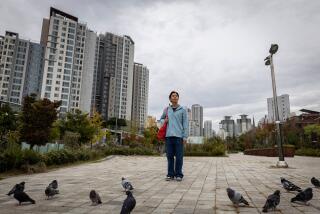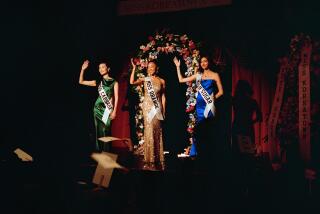Korean Roots : Museum Looks Back at a Century of Immigrants’ Struggles to Live in New Land While Saving the Old
- Share via
A century after the arrival of Korean immigrants in America, the nation’s first museum memorializing their experience is opening tonight in the Mid-Wilshire district.
The museum fulfills a decades-old dream of Susan Ahn, an 80-year-old Los Angeles native whose father came to California at the dawn of the 20th Century to lead an international movement to free Korea from Japanese colonial rule.
“For so many years I have hoped for a place where we can preserve the story of our pioneers,” Ahn said. “I didn’t think I could rest in peace if I had to leave behind all the material I have without finding a safe place for them.”
Ahn, the eldest daughter of Chang Ho Ahn--one of the most respected figures in modern Korean history--has kept the family’s historical documents, letters, artifacts and old photographs in her Northridge home since her mother’s death in 1969.
“Sometimes my mother didn’t have anything to eat, but she carted these things everywhere we went,” she said of her mother, Hye Ryon, who as a bride had followed her husband to California in 1902.
To support her five American-born children through the many years that her husband worked to mobilize Koreans in Mexico, Cuba, Manchuria, China and Siberia to free their homeland, she cleaned houses, picked grapes and ran fruit stands by day and cracked walnuts and sewed by night.
The family’s collection has long been a valuable resource for students of Korean American history. The Ahns were the first known Korean family in Los Angeles, and her oldest brother, the late Hollywood actor Philip Ahn, was believed to be the first Korean born in the city. Ahn calls the early Korean immigrants “no-name heroes” because many gave half of what they earned to support the independence movement.
For now, the Korean American Museum occupies 6,000 square feet of donated space on the ground floor of a high-rise office building at 3333 Wilshire Blvd. But within a few years, museum organizers hope to acquire their own building in the area, according to Edward Jeon, chairman of the museum board. A fund-raiser last month, attended by 900 people, brought in $160,000, said Jeon, a Woodland Hills neurologist. “I am optimistic,” he said.
On display at tonight’s open house will be “Generations: The Korean American Experience,” an exhibit of 80 photographs that portrays a century of U.S. history from a Korean American perspective.
Los Angeles attorney Tong Sung Suhr, a mover behind the project, said the museum will be a “living cultural and learning center--not merely a place to preserve artifacts and historic documents.”
Suhr, whose ancestor, Philip Jaisohn, came to California in 1885, likened Koreans to transplanted trees. “Trees that have no roots die,” he said.
Three years in the planning, the Korean American Museum may well be the first successful product of intergenerational Korean cooperation in Los Angeles, the biggest center for ethnic Koreans outside Asia.
“This is the only (Korean American) organization where young people can voice their opinions and be listened to by the middle-aged and the old people,” Suhr said. He added that generational conflicts often divide the immigrant community, which is steeped in Confucian traditions.
“The museum speaks to me--it’s my salvation,” said Susan Yang, one of the younger American-born members. “Here, we have ongoing dialogues and exchange of ideas among everybody, ages 16 to 80.”
Unlike early immigrants from China and Japan who came mostly to escape poverty, Korean settling in the United States came mostly because of Japan’s encroachment on their homeland. Japan ruled Korea as a colony from 1910 to 1945. President Theodore Roosevelt set the stage for the takeover by agreeing in 1905 to Japan’s control over Korea and Manchuria in exchange for its promise not to intervene in the Philippines, which the United States had acquired after the Spanish-American War.
They also came to work, first in the sugar cane fields of Hawaii, then in the orange groves of Riverside and the rice fields of the Sacramento Valley, and as domestics and grocers in Los Angeles.
As children growing up in the 1920s in what is today Downtown, Ahn and Young Oak Kim, now 76, remember how the Los Angeles Korean community was obsessed with regaining its homeland.
Kim said his mother wanted to build up their grocery business at the corner of Figueroa and Temple streets, but his father was so absorbed by the independence movement that he spent most of his free time attending Korean patriotic meetings.
Kim’s career in the U.S. Army is another intriguing piece of Korean American history. He grew up on the margins of the mainstream, but went on to become the most celebrated Asian American soldier of World War II.
After he was drafted in 1941, Kim went to Officer Candidate School. “They knew I wasn’t Japanese because Japanese were not allowed to enter the school,” he recalled. But he was mistaken for a Chinese. “I said I was Korean and they would ask, ‘What’s that? I’d answer ‘Something like Chinese.’ ”
After his schooling, the young lieutenant was sent to the 100th Battalion, an all-Nisei unit composed of Japanese Americans. “In those days, Army people didn’t know the difference among Asians so they just assigned me to the Japanese unit,” he said.
His commander, who was aware of hard feelings between Japanese and Koreans, offered him a transfer. But Kim replied, “We are all Americans.” Kim once led the famed all-Japanese American 100th Infantry Battalion/442nd Regimental Combat Team during the war. He retired as a colonel with 18 medals, ranging from the Distinguished Service Cross to the Purple Heart and the Silver and Bronze Stars with clusters.
“Every ethnic group can make a major contribution to America,” Kim said. “Asians will always have problems in America because we don’t look American,” he said. “When youngsters go through identity crisis, they can become more secure as individuals, knowing where they came from. They can accept being Korean and that being different is all right.”
More to Read
Sign up for Essential California
The most important California stories and recommendations in your inbox every morning.
You may occasionally receive promotional content from the Los Angeles Times.










